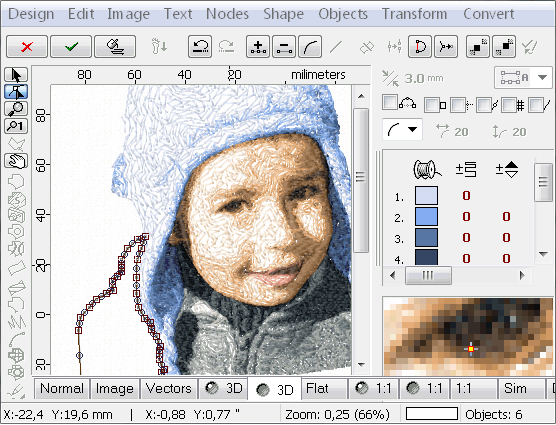Simplifying the Art of Embroidery Digitizing: Step-by-Step Overview
As modern technology continues to breakthrough, the digitization procedure has become more accessible, allowing lovers to bring their complex designs to life with convenience. In this overview, we will decipher the intricacies of needlework digitizing, breaking down each step methodically to streamline the process and empower both novices and seasoned embroiderers alike.
Comprehending Embroidery Digitizing Software Program
Embroidery digitizing software program functions as an essential tool for transforming complex layouts right into digital styles compatible with needlework makers, promoting accurate stitching and personalization. This specific software permits customers to import different image documents styles, such as JPG or PNG, and transform them into embroidery machine-readable styles like DST, EXP, or PES - Digitizing for Embroidery. By using attributes like stitch modifying, rug alternatives, and string shade option, digitizing software enables individuals to regulate every aspect of the style process
Additionally, progressed needlework digitizing software application provides devices for producing complex designs, readjusting stitch thickness, and including elaborate details. Customers can likewise sneak peek the design prior to stitching it out, ensuring precision and reducing errors. Furthermore, lots of software application give automatic attributes that help streamline the digitizing procedure, conserving effort and time.
Comprehending the capabilities of needlework digitizing software program is vital for achieving high-quality lead to embroidery projects. By understanding this device, embroidery fanatics and experts can unleash their creative thinking and bring intricate designs to life with precision and effectiveness.

Choosing the Right Design File
After familiarizing on your own with the abilities of needlework digitizing software application, the next vital action in the procedure is selecting the best style declare your job. Digitizing for Embroidery. When picking a layout apply for needlework digitizing, it's necessary to think about the complexity of the design, the size of the final item, and the type of material you will certainly be collaborating with
For elaborate layouts with great information, a high-resolution picture or vector data is suggested to make certain that the needlework machine can precisely recreate the design. Additionally, the dimension of the last item plays a substantial duty in picking the right style documents. Bigger layouts may call for higher resolution data to preserve clarity and sharpness.
Furthermore, the kind of textile you will be embroidering on influences the choice of style documents. Different textiles may need modifications in the design documents to make sure that the stitches are properly straightened and the layout shows up as intended. By very carefully choosing the appropriate design documents based on these factors, you can establish yourself up for a successful needlework digitizing process.
Digitizing Devices and Techniques
Using specialized software program and accuracy techniques, digitizing tools are vital in changing detailed designs into embroidery-ready documents. Needlework digitizing software program, such as Wilcom, Hatch, or Embrilliance, offers the required system to transform artwork into stitch information. These programs use functions like stitch editing, rug alternatives, and text devices to make certain the style translates seamlessly onto fabric.
One of the key strategies in digitizing is developing a clear path for the embroidery machine to adhere to. This entails digitizing each aspect of the design with precision, figuring out stitch types, thickness, and instructions. By utilizing devices like digitizing tablets or software-specific plugins, embroiderers can achieve a high degree of precision in their digitized styles.
Furthermore, grasping the art of rug sewing is vital for generating high quality needlework. Underlay sewing supports the fabric and creates a foundation for the design, guaranteeing that the final product is both visually attractive and resilient. By understanding these digitizing devices and strategies, embroiderers can boost their craft and bring intricate styles to life with precision and efficiency.
Tailoring Stitch Types and Directions
Having actually developed a foundation in digitizing tools and strategies, an hop over to these guys essential facet ahead of time needlework workmanship exists in tailoring stitch kinds and directions with accuracy and purpose. The option of stitch types can dramatically influence the general appearance and texture of the embroidered style. Satin stitches, known for their smooth and glossy finish, work well for producing borders and message. On the other hand, fill stitches are optimal for covering bigger locations successfully. By strategically incorporating these stitch types, embroiderers can accomplish deepness and dimension in their layouts.
Furthermore, the direction of stitches plays a crucial function in boosting the visual appeal of the final embroidery. By experimenting with various stitch angles and patterns, embroiderers can bring their styles to life with remarkable detail and details.
Screening and Refining Your Digitized Design
To ensure the accuracy and quality of your digitized layout, extensive screening and refinement are necessary action in the embroidery digitizing process. Once you have finished the digitization of your style, it is important to examine it prior to waging the real embroidery. Evaluating permits you to recognize any type of potential issues such as thread breaks, stitch density troubles, or design distortions that might influence the last outcome.

After screening, it is necessary to improve your digitized design based on the responses from the examination sew-out. This might involve tweaking stitch settings, readjusting densities, or making modifications to the general design to achieve the wanted result. By repeating through testing and improvement, you can tweak your digitized layout to excellence prior to progressing with the actual embroidery process.
Verdict
To conclude, mastering the art of needlework digitizing requires a thorough understanding of the software, selecting the ideal style documents, making use of digitizing devices and techniques, tailoring stitch types and instructions, and testing and refining the digitized layout. By complying with these steps, embroiderers can simplify the digitizing procedure and create top quality stitched layouts with precision More Bonuses and effectiveness.